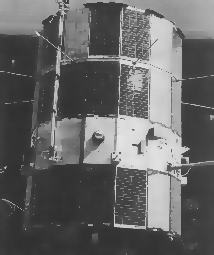
The IMP-6 satellite was launched 14 March 1971. It was placed in an
elliptical orbit with an apogee of more than 200,000 km. The 16-sided
spacecraft was 182 cm high and 135 cm in diameter. The spin axis was normal
to the ecliptic, with a spin period of 10.5 seconds. The satellite was
powered by solar cells and chemical batteries. The spacecraft reentered the
Earth's atmosphere on 2 October 1974. However, the gamma-ray instrument
failed on 26 September 1972.
The gamma-ray monitor instrument consisted of a 2.25 inch diameter x 1.5
inch thick CsI(Tl) crystal surrounded by a plastic scintillator. The
plastic served as a particle rejector. The crystal was viewed by a single
photomultiplier. The monitor was on continuously except for the passage
through the magnetotail, which occurred every 4.14 days. It operated from
launch until 2 May 1971, and then again during the period 9 June 1971 - 27
September 1972. In addition to monitoring the rates of total intensity,
particle intensity, and gamma-ray intensity, energy spectra of the incident
gamma-rays were measured in 14 channels. Spectra were accumulated
for 50% of the time, with data being collected only during the sunward half
of each satellite rotation. The spectral accumulation times were fixed at
~5.1 s. The gain of the system was cycled through 4 positions, with changes
being made roughly every week for purposes of in-flight calibration. Thus,
some data were taken with a 69-1150 keV energy range, while other data were
taken with a 53-88 keV range.
The primary purpose of the instrument was as a coincident
annihilation spectrometer incorporated in a positron detector. The
secondary objective was as a solar flare monitor, and it was in this mode
of operation that gamma-ray bursts (quite unexpectedly!) were observed.
Detailed spectra of six cosmic gamma-ray bursts were gathered, confirming
the hard X-ray or gamma-ray nature of the bursts. The maximum energy release
was seen to be at several hundred keV.